1,多尺度特征图检测网络结构;
2,anchor boxes生成;
3,ground truth预处理;
4,目标函数;
5,总结
图0-1 SSD与MultiBox,Faster R-CNN,YOLO原理(此图来源于作者在eccv2016的PPT)
图0-2 SSD检测速度与精确度。(此图来源于作者在eccv2016的PPT)
1 多尺度特征图检测网络结构
SSD的网络模型如图1-1所示。
图1-1 SSD模型结构。(此图来源于原论文)
模型建立源代码包含于ssd_vgg_300.py中。模型多尺度特征图检测如图1-2所示。模型选择的特征图包括:38×38(block4),19×19(block7),10×10(block8),5×5(block9),3×3(block10),1×1(block11)。对于每张特征图,生成采用3×3卷积生成 默认框的四个偏移位置和21个类别的置信度。比如block7,默认框(def boxes)数目为6,每个默认框包含4个偏移位置和21个类别置信度(4+21)。因此,block7的最后输出为(19*19)*6*(4+21)。
图1-2 多尺度特征采样(此图来源:知乎专栏)
其中,初始化参数如下:
"""
Implementation of the SSD VGG-based 300 network.
The default features layers with 300x300 image input are:
conv4 ==> 38 x 38
conv7 ==> 19 x 19
conv8 ==> 10 x 10
conv9 ==> 5 x 5
conv10 ==> 3 x 3
conv11 ==> 1 x 1
The default image size used to train this network is 300x300.
"""
default_params = SSDParams(
img_shape=(300, 300),#输入尺寸
num_classes=21,#预测类别20+1=21(20类加背景)
#获取feature map层
feat_layers=['block4', 'block7', 'block8', 'block9', 'block10', 'block11'],
feat_shapes=[(38, 38), (19, 19), (10, 10), (5, 5), (3, 3), (1, 1)],
# 每个特性层上的anchor大小都不一样, 越靠近输入的层其anchor越小。
# 确定第一个与最后一个feature层的anchor大小以后, 处于中间的层的anchor大小则通过线性插值计算而来。例如,假如anchor_size_bounds = [0.2, 0.7], 有6个feature layer,则每个layer对应的default anchor大小为:[0.2, 0.3, 0.4, 0.5, 0.6, 0.7].
anchor_size_bounds=[0.15, 0.90],
#anchor boxes的大小
anchor_sizes=[(21., 45.),
(45., 99.),
(99., 153.),
(153., 207.),
(207., 261.),
(261., 315.)],
#anchor boxes的aspect ratios
anchor_ratios=[[2, .5],
[2, .5, 3, 1./3],
[2, .5, 3, 1./3],
[2, .5, 3, 1./3],
[2, .5],
[2, .5]],
anchor_steps=[8, 16, 32, 64, 100, 300],#anchor的层
anchor_offset=0.5,#补偿阀值0.5
normalizations=[20, -1, -1, -1, -1, -1],#该特征层是否正则,大于零即正则;小于零则否
prior_scaling=[0.1, 0.1, 0.2, 0.2]
)
建立模型代码如下,作者采用了TensorFlow-Slim(类似于keras的高层库)来建立网络模型,详细内容可以参考TensorFlow-Slim网页。
#建立ssd网络函数
def ssd_net(inputs,
num_classes=21,
feat_layers=SSDNet.default_params.feat_layers,
anchor_sizes=SSDNet.default_params.anchor_sizes,
anchor_ratios=SSDNet.default_params.anchor_ratios,
normalizations=SSDNet.default_params.normalizations,
is_training=True,
dropout_keep_prob=0.5,
prediction_fn=slim.softmax,
reuse=None,
scope='ssd_300_vgg'):
"""SSD net definition.
"""
# End_points collect relevant activations for external use.
#用于收集每一层输出结果
end_points = {}
#采用slim建立vgg网络,网络结构参考文章内的结构图
with tf.variable_scope(scope, 'ssd_300_vgg', [inputs], reuse=reuse):
# Original VGG-16 blocks.
net = slim.repeat(inputs, 2, slim.conv2d, 64, [3, 3], scope='conv1')
end_points['block1'] = net
net = slim.max_pool2d(net, [2, 2], scope='pool1')
# Block 2.
net = slim.repeat(net, 2, slim.conv2d, 128, [3, 3], scope='conv2')
end_points['block2'] = net
net = slim.max_pool2d(net, [2, 2], scope='pool2')
# Block 3.
net = slim.repeat(net, 3, slim.conv2d, 256, [3, 3], scope='conv3')
end_points['block3'] = net
net = slim.max_pool2d(net, [2, 2], scope='pool3')
# Block 4.
net = slim.repeat(net, 3, slim.conv2d, 512, [3, 3], scope='conv4')
end_points['block4'] = net
net = slim.max_pool2d(net, [2, 2], scope='pool4')
# Block 5.
net = slim.repeat(net, 3, slim.conv2d, 512, [3, 3], scope='conv5')
end_points['block5'] = net
net = slim.max_pool2d(net, [3, 3], 1, scope='pool5')#max pool
#外加的SSD层
# Additional SSD blocks.
# Block 6: let's dilate the hell out of it!
#输出shape为19×19×1024
net = slim.conv2d(net, 1024, [3, 3], rate=6, scope='conv6')
end_points['block6'] = net
# Block 7: 1x1 conv. Because the fuck.
#卷积核为1×1
net = slim.conv2d(net, 1024, [1, 1], scope='conv7')
end_points['block7'] = net
# Block 8/9/10/11: 1x1 and 3x3 convolutions stride 2 (except lasts).
end_point = 'block8'
with tf.variable_scope(end_point):
net = slim.conv2d(net, 256, [1, 1], scope='conv1x1')
net = slim.conv2d(net, 512, [3, 3], stride=2, scope='conv3x3')
end_points[end_point] = net
end_point = 'block9'
with tf.variable_scope(end_point):
net = slim.conv2d(net, 128, [1, 1], scope='conv1x1')
net = slim.conv2d(net, 256, [3, 3], stride=2, scope='conv3x3')
end_points[end_point] = net
end_point = 'block10'
with tf.variable_scope(end_point):
net = slim.conv2d(net, 128, [1, 1], scope='conv1x1')
net = slim.conv2d(net, 256, [3, 3], scope='conv3x3', padding='VALID')
end_points[end_point] = net
end_point = 'block11'
with tf.variable_scope(end_point):
net = slim.conv2d(net, 128, [1, 1], scope='conv1x1')
net = slim.conv2d(net, 256, [3, 3], scope='conv3x3', padding='VALID')
end_points[end_point] = net
# Prediction and localisations layers.
#预测和定位
predictions = []
logits = []
localisations = []
for i, layer in enumerate(feat_layers):
with tf.variable_scope(layer + '_box'):
#接受特征层的输出,生成类别和位置预测
p, l = ssd_multibox_layer(end_points[layer],
num_classes,
anchor_sizes[i],
anchor_ratios[i],
normalizations[i])
#把每一层的预测收集
predictions.append(prediction_fn(p))#prediction_fn为softmax,预测类别
logits.append(p)#概率
localisations.append(l)#预测位置信息
return predictions, localisations, logits, end_points
2 anchor box生成
对每一张特征图,按照不同的大小(scale) 和长宽比(ratio) 生成生成k个默认框(default boxes),原理图如图2-1所示(此图中,默认框数目k=6,其中5×5的红色点代表特征图,因此:5*5*6 = 150 个boxes)。
每个默认框大小计算公式为:,其中,m为特征图数目,为最底层特征图大小(原论文中值为0.2,代码中为0.15),为最顶层特征图默认框大小(原论文中为0.9,代码中为0.9)。
每个默认框长宽比根据比例值计算,原论文中比例值为,因此,每个默认框的宽为,高为。对于比例为1的默认框,额外添加一个比例为的默认框。最终,每张特征图中的每个点生成6个默认框。每个默认框中心设定为,其中,为第k个特征图尺寸。
图2-1 anchor box生成示意图(此图来源于知乎专栏)
源代码中,默认框生成函数为ssd_anchor_one_layer(),代码如下:
#生成一层的anchor boxes
def ssd_anchor_one_layer(img_shape,#原始图像shape
feat_shape,#特征图shape
sizes,#预设的box size
ratios,#aspect 比例
step,#anchor的层
offset=0.5,
dtype=np.float32):
"""Computer SSD default anchor boxes for one feature layer.
Determine the relative position grid of the centers, and the relative
width and height.
Arguments:
feat_shape: Feature shape, used for computing relative position grids;
size: Absolute reference sizes;
ratios: Ratios to use on these features;
img_shape: Image shape, used for computing height, width relatively to the
former;
offset: Grid offset.
Return:
y, x, h, w: Relative x and y grids, and height and width.
"""
# Compute the position grid: simple way.
# y, x = np.mgrid[0:feat_shape[0], 0:feat_shape[1]]
# y = (y.astype(dtype) + offset) / feat_shape[0]
# x = (x.astype(dtype) + offset) / feat_shape[1]
# Weird SSD-Caffe computation using steps values...
"""
#测试中,参数如下
feat_shapes=[(38, 38), (19, 19), (10, 10), (5, 5), (3, 3), (1, 1)]
anchor_sizes=[(21., 45.),
(45., 99.),
(99., 153.),
(153., 207.),
(207., 261.),
(261., 315.)]
anchor_ratios=[[2, .5],
[2, .5, 3, 1./3],
[2, .5, 3, 1./3],
[2, .5, 3, 1./3],
[2, .5],
[2, .5]]
anchor_steps=[8, 16, 32, 64, 100, 300]
offset=0.5
dtype=np.float32
feat_shape=feat_shapes[0]
step=anchor_steps[0]
"""
#测试中,y和x的shape为(38,38)(38,38)
#y的值为
#array([[ 0, 0, 0, ..., 0, 0, 0],
# [ 1, 1, 1, ..., 1, 1, 1],
# [ 2, 2, 2, ..., 2, 2, 2],
# ...,
# [35, 35, 35, ..., 35, 35, 35],
# [36, 36, 36, ..., 36, 36, 36],
# [37, 37, 37, ..., 37, 37, 37]])
y, x = np.mgrid[0:feat_shape[0], 0:feat_shape[1]]
#测试中y=(y+0.5)×8/300,x=(x+0.5)×8/300
y = (y.astype(dtype) + offset) * step / img_shape[0]
x = (x.astype(dtype) + offset) * step / img_shape[1]
#扩展维度,维度为(38,38,1)
# Expand dims to support easy broadcasting.
y = np.expand_dims(y, axis=-1)
x = np.expand_dims(x, axis=-1)
# Compute relative height and width.
# Tries to follow the original implementation of SSD for the order.
#数值为2+2
num_anchors = len(sizes) + len(ratios)
#shape为(4,)
h = np.zeros((num_anchors, ), dtype=dtype)
w = np.zeros((num_anchors, ), dtype=dtype)
# Add first anchor boxes with ratio=1.
#测试中,h[0]=21/300,w[0]=21/300?
h[0] = sizes[0] / img_shape[0]
w[0] = sizes[0] / img_shape[1]
di = 1
if len(sizes) > 1:
#h[1]=sqrt(21*45)/300
h[1] = math.sqrt(sizes[0] * sizes[1]) / img_shape[0]
w[1] = math.sqrt(sizes[0] * sizes[1]) / img_shape[1]
di += 1
for i, r in enumerate(ratios):
h[i+di] = sizes[0] / img_shape[0] / math.sqrt(r)
w[i+di] = sizes[0] / img_shape[1] * math.sqrt(r)
#测试中,y和x shape为(38,38,1)
#h和w的shape为(4,)
return y, x, h, w
3 ground truth预处理
训练过程中,首先需要将label信息(ground truth box,ground truth category)进行预处理,将其对应到相应的默认框上。根据默认框和ground truth box的jaccard 重叠来寻找对应的默认框。文章中选取了jaccard重叠超过0.5的默认框为正样本,其它为负样本。
源代码ground truth预处理代码位于ssd_common.py文件中,关键代码如下:
#label和bbox编码函数
def tf_ssd_bboxes_encode_layer(labels,#ground truth标签,1D tensor
bboxes,#N×4 Tensor(float)
anchors_layer,#anchors,为list
matching_threshold=0.5,#阀值
prior_scaling=[0.1, 0.1, 0.2, 0.2],#缩放
dtype=tf.float32):
"""Encode groundtruth labels and bounding boxes using SSD anchors from
one layer.
Arguments:
labels: 1D Tensor(int64) containing groundtruth labels;
bboxes: Nx4 Tensor(float) with bboxes relative coordinates;
anchors_layer: Numpy array with layer anchors;
matching_threshold: Threshold for positive match with groundtruth bboxes;
prior_scaling: Scaling of encoded coordinates.
Return:
(target_labels, target_localizations, target_scores): Target Tensors.
"""
# Anchors coordinates and volume.
#获取anchors层
yref, xref, href, wref = anchors_layer
ymin = yref - href / 2.
xmin = xref - wref / 2.
ymax = yref + href / 2.
xmax = xref + wref / 2.
#xmax的shape为((38, 38, 1), (38, 38, 1), (4,), (4,))
(38, 38, 4)
#体积
vol_anchors = (xmax - xmin) * (ymax - ymin)
# Initialize tensors...
shape = (yref.shape[0], yref.shape[1], href.size)
feat_labels = tf.zeros(shape, dtype=tf.int64)
feat_scores = tf.zeros(shape, dtype=dtype)
#shape为(38,38,4)
feat_ymin = tf.zeros(shape, dtype=dtype)
feat_xmin = tf.zeros(shape, dtype=dtype)
feat_ymax = tf.ones(shape, dtype=dtype)
feat_xmax = tf.ones(shape, dtype=dtype)
#计算jaccard重合
def jaccard_with_anchors(bbox):
"""Compute jaccard score a box and the anchors.
"""
# Intersection bbox and volume.
int_ymin = tf.maximum(ymin, bbox[0])
int_xmin = tf.maximum(xmin, bbox[1])
int_ymax = tf.minimum(ymax, bbox[2])
int_xmax = tf.minimum(xmax, bbox[3])
h = tf.maximum(int_ymax - int_ymin, 0.)
w = tf.maximum(int_xmax - int_xmin, 0.)
# Volumes.
inter_vol = h * w
union_vol = vol_anchors - inter_vol \
+ (bbox[2] - bbox[0]) * (bbox[3] - bbox[1])
jaccard = tf.div(inter_vol, union_vol)
return jaccard
#条件函数
def condition(i, feat_labels, feat_scores,
feat_ymin, feat_xmin, feat_ymax, feat_xmax):
"""Condition: check label index.
"""
#tf.less函数 Returns the truth value of (x < y) element-wise.
r = tf.less(i, tf.shape(labels))
return r[0]
#主体
def body(i, feat_labels, feat_scores,
feat_ymin, feat_xmin, feat_ymax, feat_xmax):
"""Body: update feature labels, scores and bboxes.
Follow the original SSD paper for that purpose:
- assign values when jaccard > 0.5;
- only update if beat the score of other bboxes.
"""
# Jaccard score.
label = labels[i]
bbox = bboxes[i]
scores = jaccard_with_anchors(bbox)#计算jaccard重合值
# 'Boolean' mask.
#tf.greater函数返回大于的布尔值
mask = tf.logical_and(tf.greater(scores, matching_threshold),
tf.greater(scores, feat_scores))
imask = tf.cast(mask, tf.int64)
fmask = tf.cast(mask, dtype)
# Update values using mask.
feat_labels = imask * label + (1 - imask) * feat_labels
feat_scores = tf.select(mask, scores, feat_scores)
feat_ymin = fmask * bbox[0] + (1 - fmask) * feat_ymin
feat_xmin = fmask * bbox[1] + (1 - fmask) * feat_xmin
feat_ymax = fmask * bbox[2] + (1 - fmask) * feat_ymax
feat_xmax = fmask * bbox[3] + (1 - fmask) * feat_xmax
return [i+1, feat_labels, feat_scores,
feat_ymin, feat_xmin, feat_ymax, feat_xmax]
# Main loop definition.
i = 0
[i, feat_labels, feat_scores,
feat_ymin, feat_xmin,
feat_ymax, feat_xmax] = tf.while_loop(condition, body,
[i, feat_labels, feat_scores,
feat_ymin, feat_xmin,
feat_ymax, feat_xmax])
# Transform to center / size.
#计算补偿后的中心
feat_cy = (feat_ymax + feat_ymin) / 2.
feat_cx = (feat_xmax + feat_xmin) / 2.
feat_h = feat_ymax - feat_ymin
feat_w = feat_xmax - feat_xmin
# Encode features.
feat_cy = (feat_cy - yref) / href / prior_scaling[0]
feat_cx = (feat_cx - xref) / wref / prior_scaling[1]
feat_h = tf.log(feat_h / href) / prior_scaling[2]
feat_w = tf.log(feat_w / wref) / prior_scaling[3]
# Use SSD ordering: x / y / w / h instead of ours.
feat_localizations = tf.stack([feat_cx, feat_cy, feat_w, feat_h], axis=-1)
return feat_labels, feat_localizations, feat_scores
#ground truth编码函数
def tf_ssd_bboxes_encode(labels,#ground truth标签,1D tensor
bboxes,#N×4 Tensor(float)
anchors,#anchors,为list
matching_threshold=0.5,#阀值
prior_scaling=[0.1, 0.1, 0.2, 0.2],#缩放
dtype=tf.float32,
scope='ssd_bboxes_encode'):
"""Encode groundtruth labels and bounding boxes using SSD net anchors.
Encoding boxes for all feature layers.
Arguments:
labels: 1D Tensor(int64) containing groundtruth labels;
bboxes: Nx4 Tensor(float) with bboxes relative coordinates;
anchors: List of Numpy array with layer anchors;
matching_threshold: Threshold for positive match with groundtruth bboxes;
prior_scaling: Scaling of encoded coordinates.
Return:
(target_labels, target_localizations, target_scores):
Each element is a list of target Tensors.
"""
with tf.name_scope(scope):
target_labels = []
target_localizations = []
target_scores = []
for i, anchors_layer in enumerate(anchors):
with tf.name_scope('bboxes_encode_block_%i' % i):
#将label和bbox进行编码
t_labels, t_loc, t_scores = \
tf_ssd_bboxes_encode_layer(labels, bboxes, anchors_layer,
matching_threshold, prior_scaling, dtype)
target_labels.append(t_labels)
target_localizations.append(t_loc)
target_scores.append(t_scores)
return target_labels, target_localizations, target_scores
#编码goundtruth的label和bbox
def bboxes_encode(self, labels, bboxes, anchors,
scope='ssd_bboxes_encode'):
"""Encode labels and bounding boxes.
"""
return ssd_common.tf_ssd_bboxes_encode(
labels, bboxes, anchors,
matching_threshold=0.5,
prior_scaling=self.params.prior_scaling,
scope=scope)
4 目标函数
SSD目标函数分为两个部分:对应默认框的位置loss(loc)和类别置信度loss(conf)。定义 为第i个默认框和对应的第j个ground truth box,相应的类别为p。目标函数定义为:
其中,N为匹配的默认框。如果N=0,loss为零。为预测框和ground truth box 的Smooth L1 loss,值通过cross validation设置为1。
定义如下:其中,为预测框,为ground truth。为补偿(regress to offsets)后的默认框()的中心,为默认框的宽和高。
定义为多累别softmax loss,公式如下:
目标函数定义源码位于ssd_vgg_300.py,注释如下:
# =========================================================================== #
# SSD loss function.
# =========================================================================== #
def ssd_losses(logits, #预测类别
localisations,#预测位置
gclasses, #ground truth 类别
glocalisations, #ground truth 位置
gscores,#ground truth 分数
match_threshold=0.5,
negative_ratio=3.,
alpha=1.,
label_smoothing=0.,
scope='ssd_losses'):
"""Loss functions for training the SSD 300 VGG network.
This function defines the different loss components of the SSD, and
adds them to the TF loss collection.
Arguments:
logits: (list of) predictions logits Tensors;
localisations: (list of) localisations Tensors;
gclasses: (list of) groundtruth labels Tensors;
glocalisations: (list of) groundtruth localisations Tensors;
gscores: (list of) groundtruth score Tensors;
"""
# Some debugging...
# for i in range(len(gclasses)):
# print(localisations[i].get_shape())
# print(logits[i].get_shape())
# print(gclasses[i].get_shape())
# print(glocalisations[i].get_shape())
# print()
with tf.name_scope(scope):
l_cross = []
l_loc = []
for i in range(len(logits)):
with tf.name_scope('block_%i' % i):
# Determine weights Tensor.
pmask = tf.cast(gclasses[i] > 0, logits[i].dtype)
n_positives = tf.reduce_sum(pmask)#正样本数目
#np.prod函数Return the product of array elements over a given axis
n_entries = np.prod(gclasses[i].get_shape().as_list())
# r_positive = n_positives / n_entries
# Select some random negative entries.
r_negative = negative_ratio * n_positives / (n_entries - n_positives)#负样本数
nmask = tf.random_uniform(gclasses[i].get_shape(),
dtype=logits[i].dtype)
nmask = nmask * (1. - pmask)
nmask = tf.cast(nmask > 1. - r_negative, logits[i].dtype)
#cross_entropy loss
# Add cross-entropy loss.
with tf.name_scope('cross_entropy'):
# Weights Tensor: positive mask + random negative.
weights = pmask + nmask
loss = tf.nn.sparse_softmax_cross_entropy_with_logits(logits[i],
gclasses[i])
loss = tf.contrib.losses.compute_weighted_loss(loss, weights)
l_cross.append(loss)
#smooth loss
# Add localization loss: smooth L1, L2, ...
with tf.name_scope('localization'):
# Weights Tensor: positive mask + random negative.
weights = alpha * pmask
loss = custom_layers.abs_smooth(localisations[i] - glocalisations[i])
loss = tf.contrib.losses.compute_weighted_loss(loss, weights)
l_loc.append(loss)
# Total losses in summaries...
with tf.name_scope('total'):
tf.summary.scalar('cross_entropy', tf.add_n(l_cross))
tf.summary.scalar('localization', tf.add_n(l_loc))
5 总结
本文对SSD: Single Shot MultiBox Detector的tensorflow的关键源代码进行了解析。本文采用的源码来自于balancap/SSD-Tensorflow。源码作者写得非常详细,内容较多(其它还包括了图像预处理,多GPU并行训练等许多内容),因此只选取了关键代码进行解析。在看完论文后,再结合关键代码分析,结构就很清晰了。SSD代码实现的关键点为:1,多尺度特征图检测网络结构;2,anchor boxes生成;3,ground truth预处理;4,目标函数。SSD和YOLOv2类似,可以实现高准确率下的实时目标检测,是非常值得研究和改进的目标检测方法。







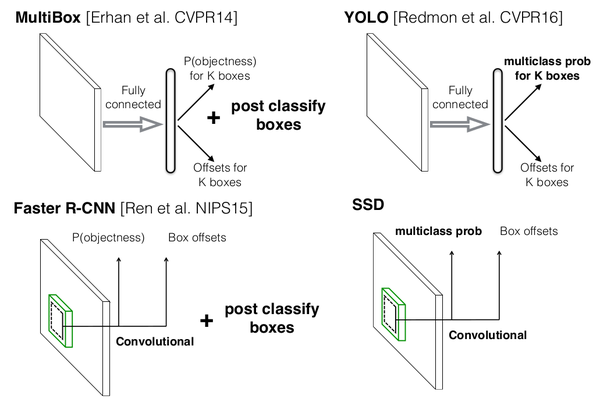
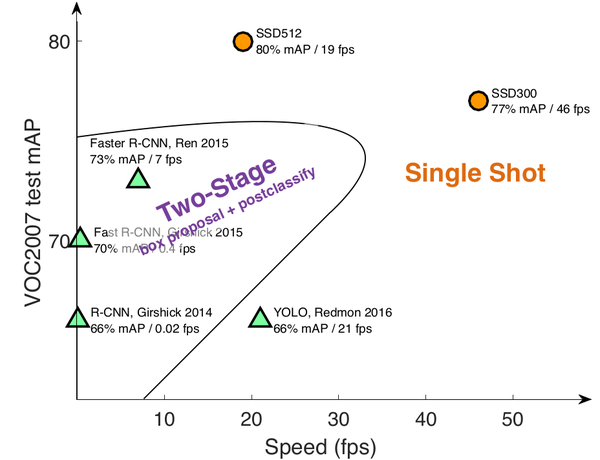
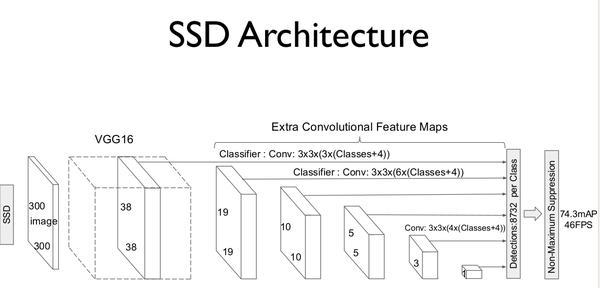
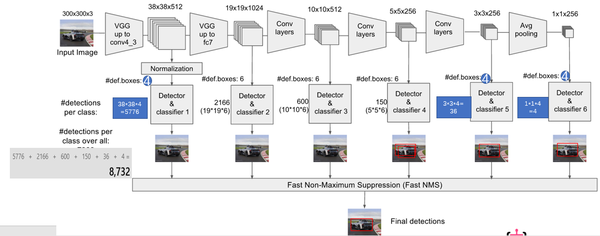
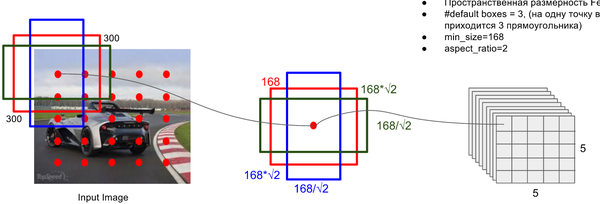
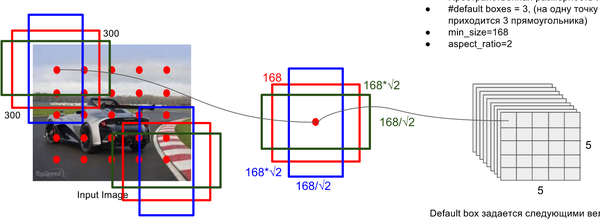
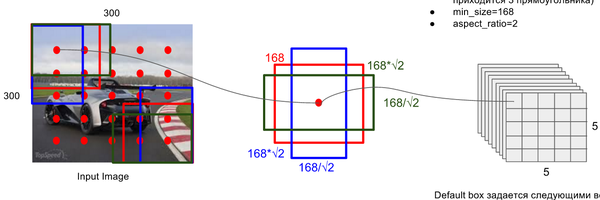

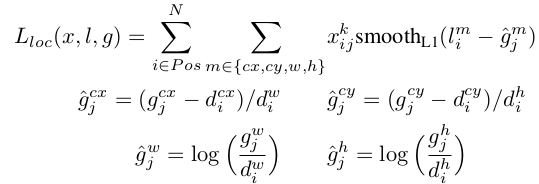 其中,
其中, 目标函数定义源码位于ssd_vgg_300.py,注释如下:
目标函数定义源码位于ssd_vgg_300.py,注释如下:













 3773
3773











 被折叠的 条评论
为什么被折叠?
被折叠的 条评论
为什么被折叠?








